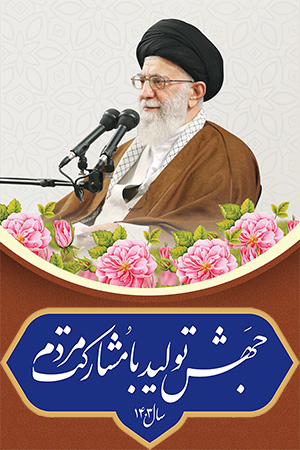Brief introduction of South Khorasan province
South Khorasan province, the easternmost province of Iran, has an area of 150,800 square kilometers.
This province is located between 57 degrees and 1 minutes to 60 degrees and 57 minutes of east longitude and 30 degrees and 31 minutes to 34 degrees and 36 minutes of north latitude, and it occupies 9.2% of the country's area.
South Khorasan province with a population of 768,898 (census of 1995) has a relative density of over 1.5 people per square kilometer, which is the lowest density in the country in proportion to the size of the province. (Table No. 1) According to the latest national divisions, South Khorasan has 11 cities (Birjand, Beshroieh, Qaenat, Ferdous, Darmian, Sarayan, Sarbisheh, Nehbandan, Zirkoh, Khosuf and Tabas), 28 cities, 25 districts, 61 villages and 3556 settlements. . (Table number two) The province is divided into two parts "mountainous and high" and "low and flat" in terms of unevenness.
The highest peaks of the province are "Kamarsorkh" with a height of 2842 meters in the north (Qaenat city, Nimblok district), "Momen Abad" with a height of 2771 meters in the center (Birjand city) and "Shahkoh" with a height of 2737 meters in the south (Nehbandan city). .
The plain and lowland areas of the province include plains and plains located in the central, northwestern, western, and southwestern parts of the province. These plains are located in the fertile parts of the north, northwest and center of the province and are of special importance in terms of agriculture, animal husbandry and the construction of communication roads. The plains of the south, northwest (Bashravieh) and southwest of the province
They contain salt flats and low and low places that are sometimes devoid of any kind of vegetation and due to their proximity to the eastern edge of the salt desert (Firdous city) and the northern edge of the Lut desert (Nehbandan city), they have a dry and harsh climate and are exposed to due to low rainfall, the rainy season ends in the last months of winter and early spring.
The climate of the province is dry and desert. The average annual rainfall of the province reaches 133 mm, which is mostly in the form of torrential and non-intermittent rains. The maximum absolute temperature of the province was 48 degrees Celsius recorded in Beshravieh and the lowest observed temperature was 23 degrees Celsius in Qain. The hot season is long in the province and lasts from late May to
It covers the end of September. The cold months of the year include December, December, February, until mid-March.
In terms of agriculture, in 1995, the province has 154,710.09 hectares of agricultural and garden lands under irrigated and rainfed crops with an area of 77,307.26 hectares with a production of 483,513.68 tons and 77,402.83 hectares of garden lands with a production of 114,443 tons.
Its most important products include barberry, saffron, jujube, cotton and narcissus.
The main medicinal plants
including angouzeh, licorice, vasha, thyme, khakhar, cumin, calpura, yarrow, yarrow, chamomile, coma, aloe vera, sumac, peppermint and local mint, lemon, lavender, rosemary, cypress, mountain almond, thousand thorns, Guinea black, Chakrah, Ajowa, Jobek Herati, Barijeh, Bene, Work, Ermak, Qadomeh, Jaedeh, Garg Tigh, Desert Chelipai, Qaliyank and Esfand Rumi.
The province's water resources include 3299 wells, 2189 springs and 6252 aqueducts with an annual discharge of 1123.01 million cubic meters.
Advantages and capabilities of the agricultural sector of the province
1- The establishment of the province in the north-south and east-west direction and its impact on all aspects of development, especially agriculture
2- The existence of relative advantages of some agricultural products, especially the first rank in the production of barberry and jujube, the second rank in the production of saffron, the fifth rank in the production of narcissus flowers and livestock products such as the existence of a complete cycle of chicken meat production, rich genetic reserves of livestock
3- The possibility of using the plains and the edge of the desert to raise livestock such as camels (about 15% of the camel population of the country) and Balochi sheep with the production of high quality wool and fluffy goats with the production of fluff with high economic value and some compatible agricultural products.
4- Possessing local and traditional knowledge in the optimal use of water and soil resources and taking the first place in the country in the number of canals
5- The possibility of forming and setting up agricultural joint-stock companies and agricultural training centers and agricultural and natural resources research centers in order to cultivate specialized human resources and implement research projects in dry and desert areas.
- Investment priorities in the agricultural sector
1- Construction of medicinal plant production complexes
2- Creation of mechanized gardens and farms for barberry and saffron cultivation
3- Creating large greenhouse complexes and producing all kinds of vegetables, oyster mushrooms, vegetables and 000
4- Construction of industrial slaughterhouses for livestock and poultry and side industries (canning)
5- Construction of chicken, egg and mother hen production complexes
6- Cultivation of warm water and cold water fish in existing water resources
7- Construction of industrial farms
8- Creation and activation of concentrate production factories
9- To activate the production units of dairy products in the province
10- Creation of dry packaging units with emphasis on the products of the province, including barberry
, jujubes, pistachios, almonds, dates and the like
11- Creation of processing units for expanding olive products
12- Industrial units related to organic and biological fertilizers with emphasis on the use of raw materials available in the province




















قوانين و مقررات
اشتراک
گزارش